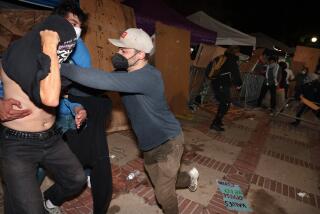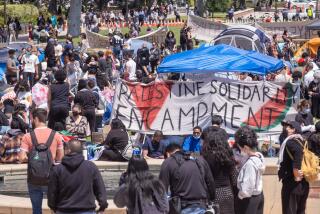Memories of Tahrir Square: A revolution ‘too perfect to be sustained’
CAIRO -- Before Jan. 25, 2011, I rarely spent time in Tahrir Square. For me, like millions of other Cairenes, it was no more than a busy downtown traffic hub you’d pass through on the way to somewhere else.
So it still seems surreal to recall the first protest against longtime ruler Hosni Mubarak three years ago – and the cascade of events that have taken place in the square since I was there that day reporting for the Los Angeles Times.
Police easily dispersed that initial gathering of a few hundred protesters on Jan. 25, and I remember wandering around an almost empty square late that afternoon, trying to find an open eatery. Yet to my amazement, and that of the security forces, more people, thousands of them, began filing into the square as the evening progressed.
The look in the protesters’ eyes clearly said: What do we do now? The cops looked equally stunned, as if asking themselves: Where did all these people come from? And what do we do with them?
It summed up how spontaneous the first hours of the revolt were. It did make one thing clear, however. Things had changed forever, as had the way Egyptians think of themselves and the world around them.
“It is here where I finally found out that being Egyptian isn’t a disgrace anymore,” one protester, who had struggled to conceal his roots while studying in Europe, told me that evening three years ago. “For decades, we were told by our rulers and their media that we are ... lower-league human beings, that we don’t deserve any better than what we have, and we believed it. Here in the square, everything I’m seeing proves them wrong.”
In a voice filled with emotion, he added, “I’m finally proud to say that I’m Egyptian.”
By night’s end, police again forcibly evacuated the square, pushing in with police vehicles, firing tear gas and arresting scores. But it was too late: The protesters were not about to stop.
Within three days, both sides were more organized. The state was determined to prevent anyone from even reaching Tahrir. With marchers held at bay by tear gas and water cannon blasts, I finally made it into the square along with a few other reporters.
The security force looked confident while I watched what seemed to be hundreds of protesters trying to fight their way in from several sides. Little did I know that they would be followed by tens of thousands, if not hundreds of thousands, more.
The mighty police force collapsed within an hour, fleeing into the night for fear of reprisal. I saw one officer shedding his uniform as he ran. After decades of asserting authority, police felt they could no longer afford to be recognized.
I saw an idealized city in Tahrir during the 18 days until Mubarak stepped down - diverse people from across the country setting their own rules and abiding by them, with an utter awareness of rights and responsibilities even among the poorest and least educated.
Tasks were equally divided among the protesters, who eventually ranged from liberal secularists to Islamist firebrands. Some guarded the square or provided food and medical care, others organized cultural and artistic events. Tahrir had everything Egypt had lacked. It didn’t matter what anyone’s name, gender or religion was. Class and wealth – crucial factors among Egyptians’ social interactions – stood for nothing.
But the scene at Tahrir was too perfect to be sustained.
Almost every other Friday for the next three years, I’d hear the same refrain from demonstrators in Tahrir: “We are here to call for the fulfillment of the revolution’s demands” – freedom, bread and social justice.
With time, people grew suspicious and disillusioned. Factions began using Tahrir to fight over spoils that didn’t even exist.
Tightly organized Islamists stepped in with all their weight, capitalizing on the vacuum of power. Liberals who lacked any sense of cohesion felt they were being deceived, but had no idea how to salvage their revolution. The Tahrir that symbolized unity became a platform for division.
“I don’t know exactly why I’m here, or what we can achieve by being here now, but something is wrong in the country, and I couldn’t stay and watch it from home any longer,” one protester said at one of the “million man marches” in March 2011, just a month after Mubarak’s exit.
It was in November when the Muslim Brotherhood, Egypt’s biggest bloc, stopped using the square for protests, while thousands of secularists battled police, angry that there’d been no sign of reform. At least 70 people were killed over six days of fighting that month.
“You feel like there is an evil soul that is casting its spell over this square,” one activist and blogger told me at the time. The sound of birdshot and tear gas canisters being fired at young protesters still rings in my ears. Motorbikes carried the injured to field hospitals.
Tahrir became an emblem of instability and violence - regardless of who was to blame for the fighting. I remember when shop owners and people living nearby started confronting protesters and asking them to go home.
“My store was completely destroyed during various violent incidents over the past year. What is the point of just protesting and damaging people’s lives like this?” a stationery shop owner in one of the roads overlooking Tahrir told me. “There is a time for revolution and there is a time for work and politics. You can’t just live your life marching in the streets and squares like some demonstrators are doing.”
In 2012, as we waited for presidential elections. The square was transformed into a venue for endorsing Islamist presidential candidates. Then, after Mohamed Morsi’s election, the demographics in Tahrir marches started changing. First, Morsi’s supporters came out in the tens of thousands calling for an “Islamic constitution.” It wasn’t long before secularists started taking to the square as well, denouncing the president. This time, the revolutionaries weren’t alone in their demands.
“I’ve always been a long-lasting supporter of Mubarak. I wasn’t even in favor of the 2011 revolt, but now I’m here because I don’t trust either Morsi or his Brotherhood,” a 62-year-old engineer, who was taking part in his first-ever protest, told me in late 2012.
That phenomenon was even more obvious when millions went out to protest Morsi’s rule. On June 30, 2013, Tahrir, among many other squares, was once again packed with protesters, and soon the military would topple Morsi.
The revolutionaries of 2011 were in the square last June, but there was no unity about the future. The revolutionaries, who once filled the square with light and hope, were now caught between Islamists’ anger at losing their dream of a religious state and others who long for stability, even within autocratic boundaries.
Today, security is again tight, helicopters circle overhead. The ideal city is long gone and many Egyptians want to see Tahrir exist again as nothing more than a busy traffic hub.
ALSO:
Los Angeles man detained amid sweeping crackdown in Egypt
Memories of Tahrir Square: A revolution ‘too perfect to be sustained’
U.S. prepared to evacuate Americans if needed during Sochi Olympics
Hassan is a special correspondent. He covered the 2011 uprising in Tahrir Square for The Times.
More to Read
Sign up for Essential California
The most important California stories and recommendations in your inbox every morning.
You may occasionally receive promotional content from the Los Angeles Times.










